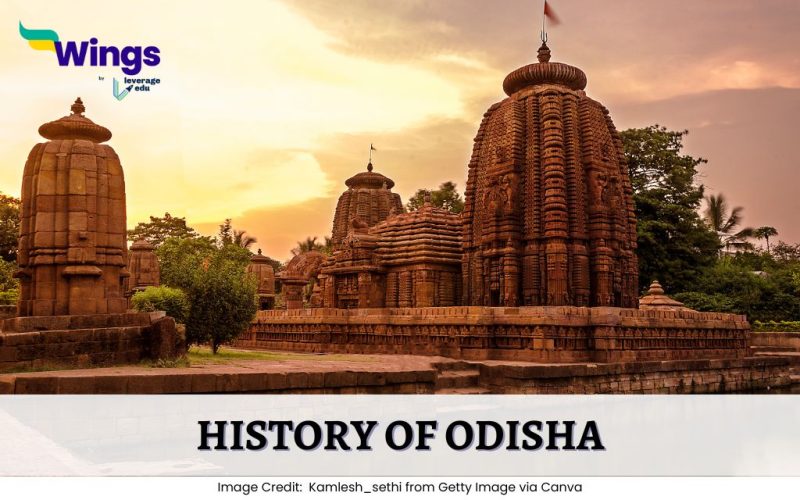Odisha, the land of ancient temples and heroic stories, has a history that dates back thousands of years. Oshia is the place where the Kalinga War transformed Emperor Ashoka’s life. It is also the place of architectural wonders like the Konark and Puri temples. The state was once a maritime kingdom, and its influence spread across Southeast Asia. The people of Odisha have also shown valour in fighting against colonial rule. Do you want to understand the history of Odisha in depth? This blog covers the top 10 facts about the history of Odisha that you never knew.
Table of Contents [show]
10 Interesting Facts About History of Odisha
Here are ten interesting facts about the history of Odisha that you never knew. Read these interesting facts and let us know which one surprised you the most.

1. Odisha was Known as Kalinga
To understand the history of Odisha, you need to know its ancient name. Odisha was known as Kalinga. Kalinga was a powerful kingdom and is mentioned in the Mahabharata, the Puranas. At the time of the Mauryan Empire, the state held significant political power. The Kalinga war (261 BCE) between the Emperor Ashoka and Kalinga transformed the Emperor’s life and shifted him towards Buddhism. The state was also known as Utkal.
2. Emperor Ashoka was Transformed After the Kalinga War
The history of Odisha cannot be understood without understanding the Kalinga War. The Kalinga War of 261 BC is the bloodiest battle held in ancient India. The war witnessed around 100,000 casualties. This remorse turned the Emperor to embrace Buddhism, and resulted in peace across the empire. The war site, Dhauli, has a rock on which non-violence is preached. The war resulted in the spread of Buddhism across the world.
3. Kharavela, the Jain Emperor, ruled Odisha during the 1st Century
King Kharavela of the Mahameghavahana dynasty ruled the state in the 1st century BC. The King was a patron of Jainism and even built caves for Jain monks. That is, the Udayagiri and Khandagiri caves. The Hathigumpha inscription was an inscription he made that details his public works and military conquests. Kharavela received the glory after the decline of Ashoka. His reign is marked as a golden era of Odisha.
4. Odisha is Known for its Temple Architecture
Odisha is a state that is popular for its temple architecture. For example, the Sun Temple of Konark was built in the 13th century. Similarly, the Jagannath Temple in Puri was also built around this period. Another famous temple in the region is the Konark Temple, which is built in the form of a chariot. This is another fact about the history of odisha. This temple is also a UNESCO World Heritage site. The credit for building these popular monuments goes to the Eastern Ganga dynasty that ruled the state between the 11th and the 15th century.
5. Maritime Power, and International Influence
The ancient ports of Odisha, like the Tamralipti and the Palur, assisted in trade with Rome, South East Asia and China. Moreover, the Indonesian-Sailendra dynasty of Java had Kalinga origins. This influenced the culture and art in the country. Odisha people were also famed for its shipbuilding and navigation skills. The state has been involved in the export of spices, textiles and other goods.
6. The Rule of the Mughals and the Marathas
Odisha was ruled by the Afghan Sultanate of Bengal (1568). Starting from this period, the history of Odisha’s independence was over. Later on, the Mughals came into power, and under the rule of Akbar, the state was annexed in 1560. Thereafter, the Marathas came and took control of the state in 1751. This promoted literature and culture in the state. After defeating the Marathas, the British took control of the state and ruled from 1803 onwards.
7. The Modern Odisha was Formed Around 1936
On April 1st 1936, Odisha became a separate province. This unified all the Odia-speaking people in the region. This day is also known as the Utkala Dibasa or the Odisha Day. The movement to make Odisha into a separate state was started by the Utkal Sammilani and Madhusudan Das. After 1947, all the princely states united and merged into one. However, the status of a state was obtained only after 1950, after Indian independence.
8. Odisha is Home to 62+ Tribal Communities
The history of Odisha is witnessed by the tribal groups. After all, the state is home to more than 62 tribal communities. This includes tribal communities like the Gond, Santhal, and Juang. These communities preserve the languages, traditions and the art of the state. For example, the Sabar people have been mentioned in the ancient text- the Mahabharata. Tribal festivals like the Dhanu Yatra and the Chhau dance are celebrated in the state.
9. The Paika Rebellion of 1817 Showcased Colonial Resistance
The Paika Rebellion of 1817 is etched in the history of Odisha. This was one of the first rebellions against British rule. Bakshi Jagabandhu led the rebellion against the land revenue system. The rebellion has been suppressed and it has inspired freedom movements. The people of Odisha have also played a crucial role in the Salt Satyagraha of 1930.
10. In 2011, the State’s Name was Changed from Orissa to Odisha
Odisha was earlier known as Orissa. However, its name was changed in 2011 to showcase the native pronunciation. Similarly, the language Oriya has also remained as Odia. Today, Odia is recognised as a classical language. The move corrected the spelling errors made during colonial rule. The people of the state today embrace the history of Odisha.
Also Read:
- 11 Facts about the Land Of High Passes, Ladakh
- Top 10 Unknown Countries of the World You Didn’t Know About
- 12 Interesting Facts About Indonesia
History of Odisha PDF
Download the: The History of Odisha PDF
FAQs about History of Odisha
The Odisha state was known as Kanliga during the ancient period. The state was also known as Utkal. Odisha is popularly known as the land of Lord Jagannath. It was the place where Emperor Ashoka conquered the region and decided to shift to Buddhism.
The first King of Odisha is Kharavela, the Kalinga emperor. It was the 1st century, and the king conquered several territories that together were called the Kalinga empire. The Kalinga empire was a maritime power.
The modern state of Odisha was founded by Madhusudan Das. He was an Indian lawyer and a social reformer. He founded the Utkal Sammilan (1903) to unify the region and campaigned to make it a state.
Find more interesting facts here!
These were the facts about medieval castles. If you find it fascinating and wish to read more such interesting facts, then stay tuned to the General Knowledge page of Leverage Edu.
 One app for all your study abroad needs
One app for all your study abroad needs















 45,000+ students trusted us with their dreams. Take the first step today!
45,000+ students trusted us with their dreams. Take the first step today!
